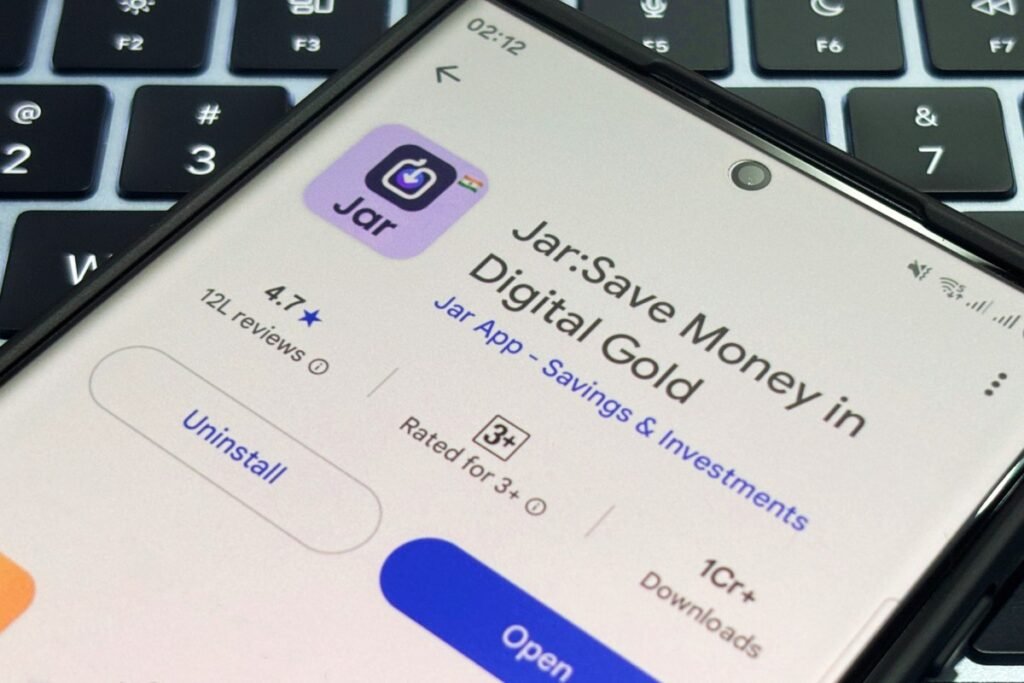Jar, an Indian fintech startup that allows users to invest in gold, has turned profitable by helpinghelps millions of first-time savers use its app to build digital gold holdings.
While many consumer fintechs focus on affluent urban users or credit products, Jar has gained traction by offering a culturally familiar asset — gold — as a low-barrier entry point to saving. The four-year-old startup targets low- to middle-income users —a segment often underserved by traditional financial institutions—by allowing them to save in gold for as little as ₹10 (about $0.11) a day.
That strategy has helped Jar reach over 35 million registered users across 12,000 zip codes, co-founder and CEO Nishchay AG said in an interview. About 60% of users are from India’s smaller cities and towns (known as tier-2 and tier-3 towns), and more than 95% are saving formally for the first time, he told TechCrunch.
The startup’s financials reflect this momentum, and two sources familiar with the matter tell TechCrunch that it is even planning to go public next year. Investment bankers are engaging with the startup for its IPO, the sources said.
These bankers have a compelling growth story to share. Jar’s operating revenue — primarily from its core gold-saving app — grew ninefold in fiscal year 2024, which ended in March, to ₹2.08 billion (roughly $23.6 million), as disclosed in its latest filing. More dramatically, its total revenue across all business lines during that same period jumped to ₹24.50 billion (approximately $279.3 million), representing a 49-fold jump from ₹500 million ($5.7 million) in the previous financial year (FY24).
This total revenue figure includes earnings from digital gold transactions, jewelry sales through its Nek platform, and fees from third-party distribution partnerships (similar to how companies like Zillow, Square, and Delivery Hero report comprehensive revenue that includes gross transaction values alongside their core business earnings).
The jewelry component is a sizable piece of this diversified approach. Nek launched early last year to offer gold, silver, diamond, and lab-grown diamond jewelry across over 8,000 zip codes. The platform works on a drop-shipment model with zero inventory. It crossed ₹1 billion (approximately $11 million) in annual revenue last year and has been “growing steadily since,” Nishchay said.
Techcrunch event
San Francisco
|
October 27-29, 2025
Jar has been profitable after tax for the last two consecutive quarters, Nishchay told TechCrunch.
That growth ties to a bet by the company on a new direction. Until last year, Jar functioned primarily as a distribution platform working with a third-party digital gold provider — essentially acting as a middleman. Since then, it has vertically integrated its operations, building an in-house tech stack to purchase, store, and manage gold directly, with BDO serving as its statutory auditor and Brinks as its custody partner. By controlling the entire value chain, Jar can now capture a larger share of the gold value chain and even distribute its gold through third-party platforms,including the Walmart-owned fintech firm PhonePe.
Earlier this year, the Bengaluru-based startup partnered both BharatPe and Unity Small Finance Bank to let users make digital payments — both to individuals and merchants — directly through the Jar app using India’s Unified Payments Interface (UPI) system. UPI is India’s dominant digital payment network that allows instant bank-to-bank transfers using smartphones. The move opens up a new revenue stream and aims to increase user engagement and retention by broadening the app’s utility beyond just gold savings.
Jar has also been an early adopter of UPI AutoPay, a feature introduced by the Indian government in 2020 to enable recurring payments on the UPI platform. The feature has helped the startup, which only supports UPI-based payments for gold savings, drive repeat transactions from users, according to sources familiar with the matter.
“Daily savings is our hero feature, and that’s what most of our users use it for,” Nishchay said when asked how UPI AutoPay has contributed to the company’s growth.
The app serves a diverse user base. Jar’s user base spans a broad spectrum, from skilled professionals in IT and manufacturing to small business owners and daily wage workers, such as electricians, plumbers, carpenters, and construction laborers. The app supports nine Indian languages, which the company says helps it cater to users across education and income levels.
The startup has also designed its app to offer a personalized experience to users, with gamification and nudges to encourage gold savings.
“The growth team consistently built different cohorts to identify the consumer based on a lot of attributes and data signals, based on what phone you use, which location you are operating the phone, from what language, what is your consistent saving pattern, all of those things they take into consideration,” Nishchay said.
The startup counts Tiger Global, Tribe Capital, Arkam Ventures, and WEH Ventures among its investors. It has raised $63.3 million in funding to date, per Tracxn, and was last valued at more than $300 million.


